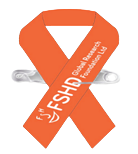GLOSSARY
4q35. A term that defines where on the chromosomes the chromosomal deletion associated with FSHD Type 1 is. It may be useful to think of it as an address. In this case, the deletion is on chromosome 4, on the “q” (long) arm at region 35.
4q35 genes. A group of genes that are located in the 4q35 region (Chromosome 4, long arm, region 35). Some of these genes will have their activity controlled by the D4Z4 repeat array.
Allele. Humans have two sets of chromosomes, and therefore two copies of each gene. One copy is inherited from your mother, the other from your father. These two copies are called alleles.
Antibody. Proteins produced by the immune system, which bind very specifically to unique features of other proteins and molecules. The immune system uses antibodies ability to bind to specific proteins to destroy foreign materials.
Antisense†oligomers. Single stranded chains of genetic material that bind to specific RNA preventing them making protein. Oligomers are used to stop the production of a particular protein.
Autophagy. This is how cells tidy up their components. By degrading unnecessary or dysfunctional components. This is done via the lysosome which act a little like a household garbage disposal unit.
Binding. The interaction of one molecule with another. This can describe a molecule sticking to another (eg. an antibody ‘binding’ to its target protein), or attaching to a cellular component to change its activity (eg. A protein that opens up a channel on the surface of the cell).
Biomarker. Measurements that may indicate a persons health status, such as tests of muscle strength, a blood test or imaging. A diagnostic biomarker will show if a person is likely to have a disease. Therapeutic biomarkers show if a therapy is likely having the desired effect.
Chromatin. The combination of DNA and proteins (primarily histones) that make up the contents of the nucleus of a cell. The main functions of chromatin are to package DNA into a smaller volume, to strengthen the DNA to allow cell division, to prevent DNA damage, and to control gene expression and DNA replication.
Chromosome. Found inside the cell nucleus, a recognizable structure comprising genes, regulatory elements and other nucleotide sequences. In humans, each cell nucleus contains 23 distinct pairs of chromosomes.
Clinical trial. Tests of drugs, diagnostics and other health interventions in human volunteers conducted to see whether the interventions being tested are safe and effective.
Cytoplasm. The cytoplasm is the jellylike part of the cell lying between the cell membrane and the nuclear membrane.
D4Z4. A repeated DNA segment of approximately 3,200 nucleotide bases. Loss of these repeats at chromosome locus 4q35 is associated with FSHD Type 1. The number of repeats can vary significantly in different individuals and can be used to diagnose FSHD and predict severity of the condition. Each D4Z4 contains a DUX4 gene. (D4Z4 gets its name from: D for DNA segment (of unknown or ‘anonymous’ nature); 4 for chromosome 4; Z to distinguish it from S (which represents a single sequence occurrence) and represents a repetitivetype equence entity; 4 representing the fourth member of this ‘class’ of sequences identified on chromosome 4.)
Deletion. Loss of part of a DNA molecule, as in “deletion of D4Z4 repeats at 4q35” associated with FSHD.
Differentiation. The process by which a less specialized cell (e.g. in an embryo) becomes a more specialized cell type , such as skin, heart, muscle, or neuron. In adults, there are many types of stem cells that differentiate into more specialised cells such as during wound healing, creating new blood cells and creating sperm.
DNA. The molecule that defines our genetic inheritance. It contains all the instructions for constructing and operating a living organism. DNA is made of four simple units , or “nucleotide bases”, whose specific sequence “spells out” genetic information.
DUX4 (Double homeobox, 4). A copy of the DUX4 gene is located within each D4Z4 repeat array on chromosome 4. Inappropriate expression of DUX4 in muscle cells is thought to contribute to FSHD .
Epigenetics. Refers to modifications that change gene function but do not change the underlying DNA sequence. Examples of these modifications are DNA methylation and histone modification , both of which serve to regulate how a gene becomes expressed as protein. Some of these changes have been shown to be heritable .
Expression profiling. The first step in converting genetic information to an observable trait involves the transfer of information from gene to protein through an intermediate molecule called RNA. Measuring all of the RNA produced in one definable moment creates a global picture of how a cell is functioning and produces a profile of total expression activity.
FISH ( fluorescent in situ hybridization ). A laboratory technique, commonly used when assessing genetic conditions. The technique uses fluorescent molecules to detect particular DNA sequences on chromosomes . The fluorescent molecules let you see where the DNA sequence is on the chromosome.
Gene. Genes specify the instructions needed to produce an observable trait such as eye colour, hair colour, or more complex traits like FSHD. A gene is a basic hereditary unit and is defined by specific segment of DNA.
Gene expression. The initial step in converting the information contained in a gene, as DNA, to an observable character through an intermediate molecule RNA.
Gene locus. Physical location, or address, of a gene on a chromosome.
Genotype. The actual DNA sequence a cell, an organism, or an individual, usually with reference to a specific characteristic under consideration.
Germ line. The collection of biological cells that give rise to gametes (that is, the egg or sperm).
Homeobox. A DNA sequence found within genes that are involved in the regulation of patterns of anatomical development. For example, homeobox genes are involved with development of the embryo and ensure the cells and structures are formed according to the DNA instructions.
Histones. The chief protein components of chromatin , acting as spools around which DNA winds. Histones play a role in gene expression.
Immortalized cells. Cells that continue to divide indefinitely, unlike normal cells which with normal aging cease to divide.
Immunocompromised. A state in which the immune system is defective and unable to mount an immune response against disease pathogens or other foreign cells.
Innervate. Formation of a functional connection between nerve and muscle or other target tissue.
Longitudinal study. A research study involving repeated observations of the same variables in the same individuals over long periods of time.
Lysosome. Cellular organelle that contain enzymes that break down waste materials and cellular debris.
Magnetic resonance imaging (MRI). A medical imaging technique using the property of nuclear magnetic resonance to image nuclei of atoms inside the body. MRI can create more detailed images of the human body than are possible with Xrays.
Magnetic resonance spectroscopy (MRS). A research technique using nuclear magnetic resonance to provide information about chemical properties of atoms and molecules.
Methylation. In biological systems, the addition of a methyl group to DNA, which can regulate the expression of genes. Some methylation changes are heritable.
Molecular pathway. A chain of chemical reactions occurring within a cell .
Mutation. A change in the nucleotide sequence in the genome of an organism with perceived deleterious effects.
Myocyte. Long, tubular cells found in muscle. Myocytes develop from myoblasts to form skeletal muscle fibers (myotubes) in a process known as myogenesis.
Nucleus. The cell nucleus contains all the genetic material (DNA) for the cell enclosed by a membrane.
Organelle. A specialized unit within a cell that has a specific function, for example, the nucleus contains all the genetic material and organelles called mitochrondria provide the cell with energy.
Pathophysiology. Physiological processes or mechanisms that lead to the development and progression of diseases and conditions.
Phenotype. The composite of an organism’s observable characteristics or traits, such as its physical form, growth, biochemical and physiological properties, and behavior.
Pluripotent cells. A stem cell that has the potential to differentiate into diverse types of cells. Induced pluripotent stem cells (iPS cells or iPSCs) are a type of pluripotent stem cell that has been made from a normal adult cell. It is turned back into a stem cell by forcing it to express certain genes.
Polycomb. A family of proteins that can alter chromatin such that genes are epigenetically silenced (not able to be expressed).
Protein. Biological molecule consisting of chains of amino acids. Proteins are the principal products of genetic information and they do the bulk of work required for life. They perform a vast array of functions within living organisms, including providing cells with structure, transmitting signals, and transporting molecules from one location to another.
Protein synthesis. The production of proteins within cells by using information encoded in genes . The genetic code on DNA is transcribed into messenger RNA, and then translated into a chain of amino acids to form protein.
Reprogramming. Conversion of a cell from one cell type to another. This involves a conversion first to a pluripotent state, then redifferentiating to the new cell type.
RNA (Ribonucleic acid). A family of large biological molecules that perform vital roles in the coding , decoding , regulation , and expression of genes. Like DNA, RNA is assembled as a chain of nucleotide “bases”, but, unlike DNA, it is usually singlestranded.
Somatic cell. The term somatic cell describes any cell forming part of the body. This excludes the reproductive cells or ‘germ line’ cells, or stem cells.
Stem cell. Undifferentiated cells that can differentiate into a variety specialised somatic cells and can divide to produce more stem cells.
Target. A protein or nucleic acid (DNA or RNA) whose activity can be modified by an external stimulus, such as a drug or another biological molecule (e.g. hormone, antibody, neurotransmitter, etc.). For example, one ‘target’ for FSHD research is the DUX4 protein.
Telomere. A region of repetitive nucleotide sequences at the tip of the arm of a chromosome, which
protects the end of the chromosome.
Transcription. The copying of DNA into messenger RNA during the process of gene expression.
Transgenic. An organism that has had genetic material (or transgene) introduced into its genome that is not its own so that it will exhibit a new property.
Translation. The process of ‘translating’ messenger RNA sequence into protein.



